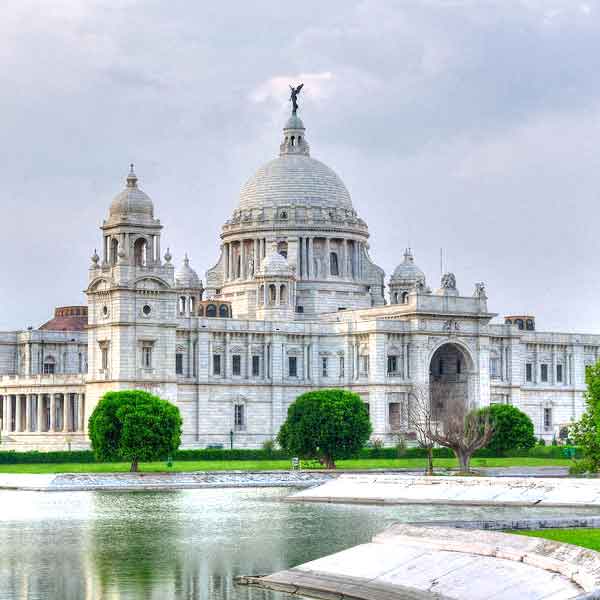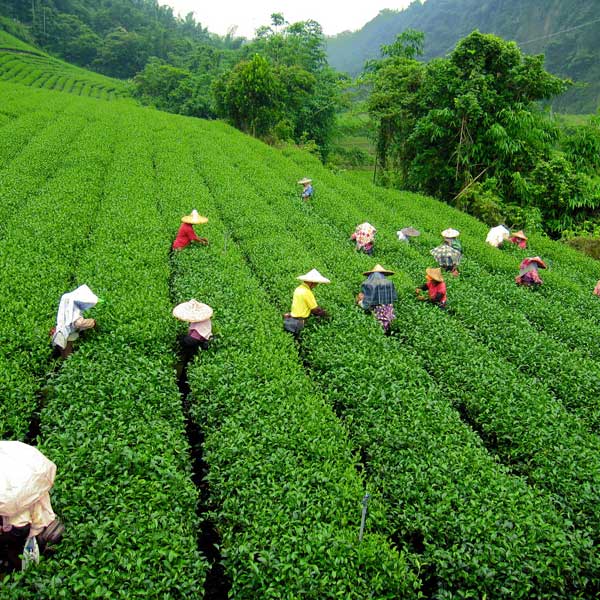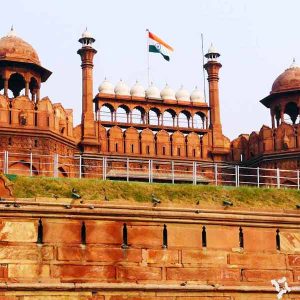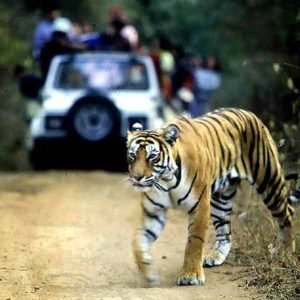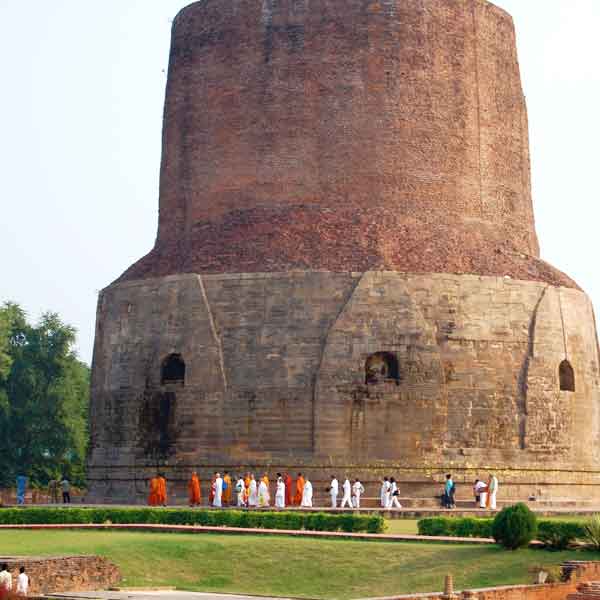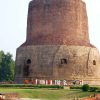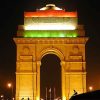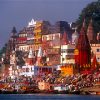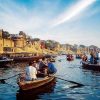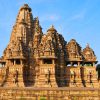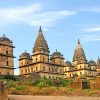Day 01: Arrive in Chennai. Transfer to Mamallapuram (Mahabalipuram).
Arrive in Chennai (formerly known as Madras), the 4th largest metropolitan area in India. Be met by our local representative, transfer to our resort in Mamallapuram for 2 nights stay, and settle in for the evening.
Mamallapuram, a serene town nestled amidst the historical stone sculptures and medieval architecture that stands witness to the rich heritage, is known for its pristine sandy beaches, its bright sunshine and tranquil setting. Here, time stands still and the present meets the past. Overnight in Mamallapuram.
Day 02: Mamallapuram. Excursion to Kanchipuram.
We proceed on a visit to Kanchipuram, one of Hinduism’s seven most sacred cities. In ancient times, the city was called Kachi and Kachiamapathi. This “Golden City of a Thousand Temples” dates back to the early Cholas in the 7th Century AD. Only approximately 70 temples of the original 1000 ancient temples are still intact, the most famous of them being the Kailasanatha Temple, a sandstone temple built in the early 7th Century designed to mirror Mount Kailash, the home of Lord Shiva. As this city is renowned for its silk weavings and hand-woven sarees, a visit to the nearby villages to see the craftsmen at work on their looms is a rewarding experience.
We return to the resort for lunch and then take a short trip to visit the magnificent site of the Shore Temple of Mamallapuram, a nearby “open air museum” which occupies a stunning position on a rocky outcrop facing the Bay of Bengal. Built by the Pallava rulers in the 7th Century, the complex comprises of 14 cave temples, 9 monolithic Rathas, 3 stone temples, and 2 bas-relief sculptured rock panels. The beauty of this site is not only due to its captivating architecture, but the vast casuarinas trees and the silvery sandy beach. Overnight in Mamallapuram.
Day 03: Mamallapuram to Puducherry (Pondicherry).
Today, we begin our drive to Puducherry, formerly known as Pondicherry, considered the French Riviera of the east. This former French colony still retains much of its French history, evident in the city’s design and architecture. Near Puducherry, we encounter Auroville, “The City of Dawn”, an intriguing experimental town. Founded by “Mother” Mirra Richard in 1968, Auroville was created to be a “universal town where men and women of all countries are able to live in peace and progressive harmony, above all creeds, all politics and nationalities. The purpose of Auroville is to realize human unity”.
Later we visit the Aurobindo Ashram, the former home of Mother Mirra and Sri Aurobindo, whose teachings start from the ancient sages of India. He taught that behind the appearance of the universe, there is the reality of a being and consciousness, a self of all things, one and eternal. He believed that all beings are united in that one self and spirit, but divided by a certain separativity of consciousness, an ignorance of their true self and reality in the mind, life and body, and that it is possible, by a certain psychological discipline, to remove this veil of separative consciousness to become aware of the true self and the divinity within all of us. We then check into a wonderful Heritage Hotel and relax for the evening.
Day 04: Puducherry to Swamimalai via Chidambaram.
This morning we make our way to Swamimalai, stopping en route in the temple town of Chidambaram, one of Tamil Nadu’s most important towns and a major pilgrimage site for Shaivites. Here we will visit the impressive Chidambaram Temple, a famous Hindu temple dedicated to Lord Shiva in his form of the Cosmic Dancer, Nataraja. This is one of the few temples where Shiva and Vishnu are enshrined under one roof. In Hindu literature, the temple is one of the holiest of the 5 Shiva Temples, each one representing one of the 5 elements, and represents the element of Akasa or Ether. The temple is an architectural wonder, one of the special features being the bejeweled image of Nataraja. It depicts the Lord Shiva as Bharatanatyam, “The Lord of the Dance”. The Cosmic Dance of Lord Nataraja symbolises the motion of the universe sustained by Lord Shiva.
Upon arrival in Swamimalai, we check into our beautiful Heritage home set amidst a lush green coconut grove. The location is a perfect base for exploring the many temples nearby.
In the afternoon we visit Swamimalai Murugan Temple, 4th among the 6 “paddai veedu”, the Sacred Shrines dedicated to Lord Muruga. According to Hindu belief, Swamimalai is where Muruga, at a young age, preached to his own father, Lord Shiva. This is also the place where, according to legend, Lord Muruga proposed the meaning of “Om”, the Sacred Pranava Mantra, to his Father Lord Shiva, and thus, assumed the title Swaminath, “Lord of Lords”. Overnight in Swamimalai.
Day 05: Swamimalai. Excursion to Thanjavur (Tanjore).
Today, after breakfast, we proceed for a full day of sightseeing in Thanjavur (Tanjore), considered the “Granary of South India” due to its agricultural activities. It is one of the oldest cities in India and is an important centre of South Indian art and architecture. It is also home to most of the “Great Living Chola Temples”, UNESCO World Heritage monuments, the foremost among them being the Brihadeshwara Temple, a brilliant example of the major heights achieved by Cholas temple architecture. As we explore this temple and complex, which stands amidst fortified walls surrounded by a moat, we will appreciate this remarkable architectural feat. The temple itself is made of hard granite stones which were not available in the area and is an amazing example of Dravidian architecture. The temple is a tribute and reflection of the power of its patron Rajaraja Chola and remains one of the greatest glories of Indian architecture. It was built as the royal temple to display the emperor’s vision of his power and relationship to the universal order and was also the site of major royal ceremonies. The Vimana, or temple tower, is 216 ft high and is among the tallest of its kind in the world. The Kalash or Shikhara (bulbous structure on the top of the temple), is itself very large and heavy. At the entrance sits a big statue of Nandi, the “Sacred Bull”, carved out of a single rock and measuring about 16 ft long and 13 ft high.
Near the temple, we visit the Thanjavur Palace of Nayaks, a huge palace constructed partly by the Nayak rulers and partly by the Maratha rulers. The entrance of the palace has a large quadrangular courtyard, which leads to a pillared hall. The palace houses a library, which contains 40,0000 rare books and palm leaf inscriptions, an art gallery, which exhibits a large collection of bronze and granite Chola sculptures, and a museum, which is home to many items and relics belonging to past kings. We return back to Swamimalai in the evening for overnight.
Day 06: Swamimalai & Kumbakonam Temples.
Today after breakfast, we head off for a full day of sightseeing, visiting some of the many temples around Swamimalai and Kumbakonam. We begin with Gangaikondan Cholapuram, an architectural work of genius. The temple was built by Rajendra Chola, who was the son and successor of Rajaraja Chola, in the early 11th Century, in an attempt to reproduce the “larger- thanlife” achievement of his father. According to legends, King Rajendra Chola, during one of the his campaigns to the north, brought back water from the river Ganges in a golden pot and sanctified the reservoir Ponneri or Cholaganga. Thus, he was given the title of Gangaikondan, “the one who brought the Ganges”. The temple has complex carvings in the Vimanas and is an exhibition of intricate detailing. Some of the sculptures found here are as great as any others found in other Chola Temples, but the most striking and unique ones here are The Nataraja, Coronation of King Rajendra Chozhan by Shiva and Parvati, the Dancing Ganesha, and the most interesting, the Ardhanari, the man-woman manifestation of Lord Shiva, signifying the duality of divine energy.
Next, we visit the ancient town of Darasuram and the Airavatesvara Temple, a Hindu temple of Dravidian architecture, considered a “sculptor’s dream in stone”, and one of the oldest of the Chola temples. This UNESCO World Heritage Site, also built by Rajaraja Chola in the 12th Century, is dedicated to Lord Shiva. It is a storehouse of art and architecture and has some exquisite stone carvings. Although this temple is much smaller than the Brihadeshwara or the Gangaikondan Cholapuram Temples, it is more exquisite in detail due to the fact that it was said to have been built with nitya-vinoda, “perpetual entertainment”, in mind.
We end our day of sightseeing with a visit to the Adi Kumbeswarar Temple, the major temple of the Shaivites. This temple, also dedicated to Lord Shiva, covers an area of 30,181 sq ft with a length and breadth of 750 ft and 252 ft respectively. The temple comprises of 3 praharas and 3 gopurams in the eastern, northern and western directions. The complex is huge and showcases beautiful artwork and intricate, colorful carvings. According to legend, Shiva caused the Amritakalasam, “the pot holding divine nectar”, to rest here during the great deluge, and the shrine is said to have been built and consecrated by Bhrama himself. The most famous festival of Mahamagam is associated with this temple and attracts crowds from all over India. Overnight in Swamimalai.
Day 07: Swamimalai to Madurai via Chettinad.
Today after breakfast, we head for Madurai stopping en route to visit Chettinad, known for its cultural heritage, architecture, and art. It is also known for its several temples and elaborate mansions. Houses in the city are built on rectangular, traversal plots that stretch across 2 streets. Their front doors open out to the first street while the back doors open out to the second. Looking in from the main threshold, the eye travels directly through, into a series of inner courtyards. The most famous Chettinad mansion is the Raja’s Palace at Kanadukathan which began construction in 1902 and took 10 years to complete. This elaborate home stretches over 40,000 sq ft, its rooms embellished with Burmese teak wood, Italian marble, and English steel.
As Chettinad is also known for its fine cuisine and culinary delicacies, make sure to sample the fine fare. Later, we continue our drive to Madurai and settle down in our hotel.
Day 08: In Madurai.
Today we enjoy a full day in Madurai, the oldest inhabited city in the Indian peninsula. One of South India’s great temple towns, Madurai is synonymous with the great Meenakshi Temple, a historic Hindu temple dedicated to Lord Shiva and his consort, the goddess Parvati. According to legend, Shiva came down to earth as Sundareswarar to marry Meenakshi, an incarnation of Parvati. The marriage was supposed to be the biggest event on earth, with all of the earth’s inhabitants gathering in Madurai. This marriage is still celebrated today in Madurai as a huge festival called Meenakshi Thirukalyanam, “the Divine Marriage of Meenakshi”. The temple, with it stunning architecture, is the heart and spirit of Madurai. At the core of the wall-enclosed complex, we find 2 sanctums for Sundarewarar and Meenakshi, surrounded by a number of smaller shrines and grand pillared halls. The 12 magnificent gopurams that tower above the surrounding countryside are striking with their intricate carvings and colorful paintings.
Later we visit the Thirumalai Nayak Palace, a 17th Century palace built by King Thirumalai Nayak. The palace was built with the aid of an Italian architect and is a classic fusion of Dravidian, Islamic, and European styling. In its day, the palace was considered one of the wonders of the south; it has now been declared a national monument. In the evening, we will have the special privilege of witnessing the evocative prayer ceremony at the Meenaskhi Temple. Overnight in Madurai.
Day 09: Madurai to Periyar.
This morning, we drive to Periyar, also known as Thekkady, set high in the mountains of Kerala and renowned for its geography and wildlife. Upon arrival, we will check into our amazing Treetop Resort and then head off for a delightfully relaxing boat ride on Periyar Lake. The boat ride is a wonderful way to take in the sights and sounds surrounding Periyar Lake, which lies in the heart of the Periyar Wildlife Sanctuary.
This National Park and Tiger Reserve is one of the most captivating wildlife parks in the world and is a perfect example of nature’s bounty. Sprawling over an area of 777 sq. km., the park is rich in biodiversity and is a repository of endangered flora and fauna. Here, visitors can witness playful pachyderms wandering freely, elephants frolicking in the waters of the lake, herds of deer prancing about, an abundance of bird species coloring the sky, along with many other animal species roaming through the park. The tiger population is also fortunately beginning to grow in this area due to the careful attention and care of concerned citizens, staff and through the support of visitors. Overnight in Periyar.
Day 10: Periyar to Alappuzha (Alleppey) Houseboat.
After breakfast, we begin our drive to Alappuzha in Kerala, fondly known as the Venice of the East and famous for its Snake Boat Races. This charming town of picturesque canals, backwaters, beaches and lagoons, is the perfect place to enjoy a little R & R. As we drift peacefully along the backwaters on our beautiful and relaxing houseboat, we can enjoy the breathtaking scenery and a microcosm of flora and fauna, as well as local villages. Overnight in Hoseboat.
Day 11: Alappuzha to Kochi (Cochin).
We enjoy breakfast on our houseboat and then make our way to the vibrant city of Kochi, also known as Cochin. On arrival, we check into an intimate hotel.
A centre of trade, Kochi merchants began trading spices such as black pepper and cardamom with the Arabs, Dutch, Portuguese, and Chinese more than 600 years ago. A striking scene here is the row of Cheena vala, Chinese fishing nets that line the mouth of the harbor, which leads to the Arabian Sea in Fort Kochi.
Spend the afternoon at your leisure strolling through this seaside city flanked by Western Ghats. Visit the museum to learn about the history of this charming town, enjoy shopping at the local antique stores and spice markets, or just relax on the beach and watch the fishermen bring in their fresh catch of the day. In the evening, we will gather together to witness the captivating Kathakali Dance Show before retiring for the evening at our Hotel.
Day 12: In Kochi.
Whole day at leisure or explore the city on your own. Overnight in Kochi.
Day 13: Kochi to Varkala.
After breakfast we are off for a full day of sightseeing. In the morning we enjoy a city tour of Kochi. We visit the Dutch Palace, originally built by the Portuguese and then later modified by the Dutch in the 17th Century, the Jewish Synagogue, magnificently decorated with Chinese tiles and Belgian Chandeliers, St. Francis Church, the oldest church built by Europeans in India, and the Santa Cruz Basilica, built by the Portuguese in 1505, destroyed by the British in 1795 and then later rebuilt in 1905. We end our tour in Fort Kochi, where we have some free time to wander through the town to admire the Dutch and Portuguese colonial architecture, which dates back to the 16th century.
In the afternoon we drive to the Ernakulam railway station and board our train for Thiruvananthapuram (Trivandrum). Upon arrival, we transfer to our beautiful beach resort in Varkala, a quaint fishing village in the southern district of Kerala, to wind down from our exciting journey.
Varkala is considered a center of pilgrimage as well as a popular, yet more tranquil beach destination than neighboring resort areas. It is the only region in southern Kerala where you can find cliffs adjacent to the Arabian Sea which creates a unique geological contrast to the otherwise surrounding flat landscape. The beaches in the area are stunning and the sea offers a refreshing respite from the Indian sun. Overnight in Varkala.
Day 14: In Varkala.
Our Resort, which sits perched on a rocky cliff and hugs the silvery-black Thiruvambady Beach, can easily be considered a tropical paradise. The lush and tropical surroundings are strewn with coconut palms; their pebbled pathways leading to lookout points offering tremendous views of virgin beaches and endless sunsets. The restaurant, which looks out to the calm sea, offers healthy and holistic cuisine, and the Ayurvedic Centre offers rejuvenating, restorative and curative therapies. This wonderful resort will be our base for the next few days so release and relax and take full advantage of this stunning setting.
Day 15: In Varkala.
Continue to enjoy the resort and all its amenities at your leisure. Stroll along the pebbled pathways for an acupressure treatment to restore sore and tired feet, explore the rocky shoreline and many coves, lay back and relax on the pristine beach, get the heart pumping and circulation flowing with an invigorating hike or bike ride, or head into town for some sightseeing. You will find 2 major attractions nearby, the 800 year old Janardana Swamy Temple and the Nature Cure Center. Overnight in Varkala.
Day 16: Varkala to Thiruvananthapuram (Trivandrum). Depart Trivandrum.
Today, bid your farewells to new found friends and remarkable South India and transfer to Trivandrum International airport for your return home.
Date and price to suit individual arrangements based on 2 people sharing. Breakfast included. Private air-conditioned car and driver with English speaking guides for sightseeing.

